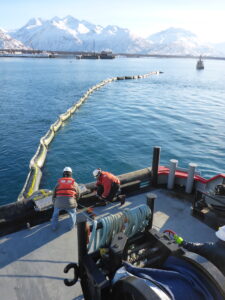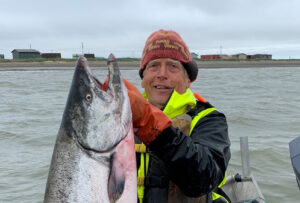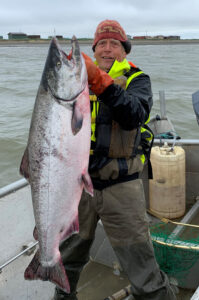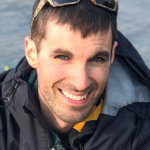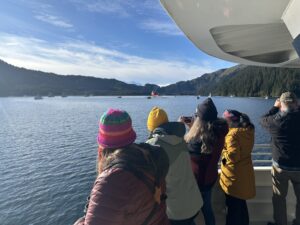
The Prince William Sound Regional Citizens’ Advisory Council held a tour for locals to observe the annual oil spill response training for fishing vessels in Whittier, Alaska, on Sept. 30, 2024. This has been an annual event since 2016, rotating through several communities in the region, though it was postponed during the height of the COVID-19 pandemic. The Whittier community was invited to join the council from 11:30 to 2 p.m., on a Stan Stephens Cruises vessel to observe the training. Over 90 members of the public participated in the event, including students from the Whittier Community School.
Whittier resident, Chase, age 12, stated about the event, “There are so many people participating and wanting to learn on this boat, learning about this to help protect our environment. Plus watching all those boats do their job in helping protect the environment. I think it’s pretty cool.”
The local fishermen and women participating in the training are contracted by the Ship Escort Response Vessel System, also known as SERVS, to respond in the event of an oil spill from a Prince William Sound tanker or the Valdez Marine Terminal. SERVS is Alyeska Pipeline Service Company’s oil spill removal organization and coordinates annual spill response exercises in multiple Southcentral Alaska communities, including Whittier.
This Council event helps keep communities informed on what oil spill prevention and response measures are in place in Prince William Sound and downstream communities, especially those involving their local fishers. Whittier residents learned about oil spill response technology, tactics and how this program helps Alyeska operate safely in Prince William Sound. Narrators from both the Council and Alyeska were on board to describe the activities so that participants could better understand the training. We would like to thank our partners, Alyeska/SERVS and Stan Stephens Glacier & Wildlife Cruises, for helping to support this event.
“I think that’s very cool for [students] to see people from their community taking part in an activity like this,” said Whittier school teacher Jennifer Childress. “Knowing what a special and important place Prince William Sound is, it’s important to have people be trained and ready to go in case an awful event like an oil spill happens. To have local people involved in that and as a teacher to have students see that they could have a place in that and be a part of that as they get older, is very important.”
Alyeska’s contracted fishing fleet is the backbone of their oil spill response system. It is essential to the system operating as it was designed to do and part of what makes the Prince William Sound system world-class. These contracted vessels and their crews help ensure the most comprehensive oil spill response measures are in place for both open water and nearshore resources. A major lesson of the Exxon Valdez oil spill was that incorporating local mariners into the spill response system helps ensure a quick, efficient and effective response.
Since the inception of SERVS after the Exxon Valdez spill, the Council has been highly supportive of local fishers and mariners being trained annually with the best available technology to prepare for oil spills. Whittier mariners have the most intimate knowledge of, and connection to, the waters in and around Whittier. Their involvement would help protect the most sensitive areas, such as hatcheries and spawning streams, from spilled oil.
Whittier school student, Ana, 12, said about the event, “I think it’s good to protect our marine wildlife and [this event] creates awareness.”
The Council has held previous fishing vessel oil spill response training tours in Valdez, Seward, Cordova and Homer. The Council hopes that through such programs communities will understand the importance of oil spill prevention and having the most robust response strategies in place in the event of a spill.
”It’s especially important for local fishing vessels to participate in the system,” said Kathy Shea, one of several representatives from the Alaska Department of Environmental Conservation’s Spill Prevention and Response Division on board the tour. “They know the water, they’re out here fishing on a regular basis and they rely on the ocean for their livelihoods. They want to pass down a clean environment to their families in the future, so having them on our team is hugely advantageous for spill response.”
Several photos of the event are available through the following link: Whittier fishing vessel training tour 2024 (Dropbox)
Additional photos are available for use on request by contacting Brooke Taylor at brooke.taylor@pwsrcac.org or 907-301-3784.
The Prince William Sound Regional Citizens’ Advisory Council, with offices in Anchorage and Valdez, is a federally mandated, independent nonprofit corporation whose mission is to promote the environmentally safe operation of the Valdez Marine Terminal and the oil tankers that use it. The council’s work is guided by the Oil Pollution Act of 1990, and its contract with Alyeska Pipeline Service Company. The council’s member organizations are communities in the region affected by the 1989 Exxon Valdez oil spill, as well as commercial fishing, aquaculture, Alaska Native, recreation, tourism and environmental groups.
